Presentation by Susan Lugo & Field Trip to the Caribbean Genealogy Library
(Summarized by Robin Swank)
If you wish to trace your ancestry, help someone trace theirs, or are just interested in written historical records, head across the water to become familiar with a real St. Thomas gem, the Caribbean Genealogy Library (CGL). [Contact the Library via email at CaribGenLibrary@attglobal.net or via telephone at 340-714-2136. Visit at Al Cohen’s Mall in Havensight.]
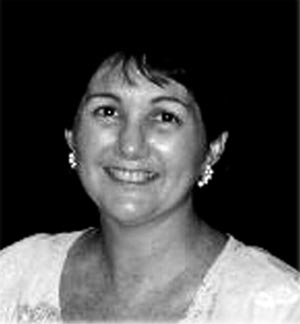
Susan Lugo
co-founder of CGL.
Co-Founder Susan Lugo gave our Tuesday Feb. 6th Membership Meeting a preview of CGL’s resources, and we followed up with a Saturday field trip. Both Ms. Lugo and Elizabeth Sharp, a founding records donor, welcomed us, and many of the research tools described at the presentation were set up for our use. With the research processes and tools described by Ms. Lugo and by our other presenters this year, we felt well-equipped to enter this archive of accessible history. Susan encouraged all of us to use, and to create demand for, genealogical records, “not only to find out about yourself,” she says, “but also to assure their survival.”
The CGL is very empowering. U.S. Virgin Islands Census Data, microfilmed Danish West Indies Census Data 1841-1911, U.S. Census Data, including Immigration Lists and Social Security Death Index, 4000 international books, local Church records, a recent donation of St. Thomas Printing’s Funeral Booklets, and microfilmed and on-line access to many, many thousands of other resources are available in this tiny space.
“A key resource is Census data,” Susan asserts, giving us a primer on the U.S. process. The U.S. Decennial Censuses began in 1790 as enumerations (counts) to validate representation/apportionment, but they evolved over time; by 1930 censuses included fairly complete demographic descriptions of the individuals enumerated. Census forms are not released to the public for 72 years, pursuant to 1952 legislation. Unless amended, this policy based on ‘agin’ actuarial tables will make publicly available, during our lifetimes, earlier census data collected on us! All U.S. Census data is available via CGL’s Ancestry.com extended on-line subscription.
Ms. Lugo cautioned us about the importance of ‘knowing’ both the enumerator and the environment in which ANY census takes place. A specific enumerator might separate households by spaces, lines, or brackets; he might indicate family members by tick-marks in esoteric columns, shorthand you’ll need to be able to read. At CGL, we saw evidence of familiar refrains: Enumerators write what they hear, so family names are often spelled differently over time; as standardized St. John Estate names were not used until 1801, tracking your local ancestors by location may be tricky; the Virgin Islands’ U.S. 1920 Census requirement was met by a census conducted after Transfer in l917, so if you are searching for local individuals in the 1918-1920 timeframe, they won’t necessarily be recorded. Although St. John’s 1917 census is largely complete, several geographic swaths of St. Thomas are missing.
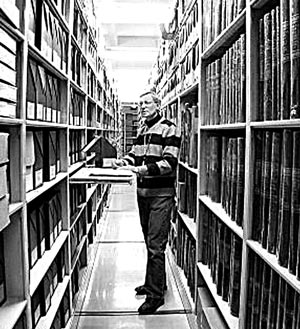
Vernon Paul Rood, PhD
Archivist at NARA.
Despite such holes, the safekeeping, copying, and distribution of census records is important. The importance is underscored by a disastrous 1921 fire which destroyed the sole copy of the Eleventh U.S. Census. This 1890 census covered a key period in U.S. history–a time of much immigration, westward migration, and industrialization, and it is lost forever.
(Picture at left, Vernon Paul Rood, PhD, Archivist at NARA. Over 2500 cubic feet of records: 5 million pages, 3600 boxes, and 3000 bound volumes of records relating to the Danish West Indies, are housed in the National Repository’s Record Group 55.)
At the National Archives and Records Administration (NARA), available through CGL, we can look at NARA Record Group 55 (Records of the Government of the Virgin Islands, DWI 1872-1917) ‘Finding Aid’, an impressive summary index, to locate available records. (To get to NARA yourself, go to http://www.archives.gov/research/. If your computer gets lost, Group 55 is key.) In addition to knowing your enumerator and the census historical context, it’s important to understand an archivist’s historical context. Throughout this finding aid, SJHS President David Knight notes, NARA has chosen to replace the Danish term “Free Coloured” with “Free Black,” possibly an uninformed thing to do, as the distinction ‘black’ had a very different connotation in the colonial period.
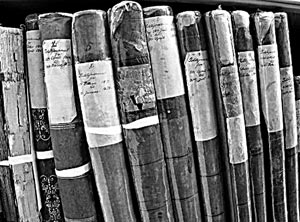
Many of the reocrds in NARA appear
unread since deposit
Susan also commended us to the online Danish Archives, where the Danish West Indies Local Archives include probate records and letters, inventories and valuations, and altogether much richer information, in fact, than modern U.S. declassified recordkeeping can boast. (Seehttp://www.sa.dk/content/us/ for an excellent overview of available records.)
The historical record of the islands was severed with Transfer, and crates of historical documents were removed to Denmark. (Some were essentially abandoned here as ‘irrelevant.’) Previously unavailable due to distance and lack of technology, much is now available on-line and distributed microfilm. These records “can help us reconnect, help us reclaim our heritage,” Ms. Lugo asserts.
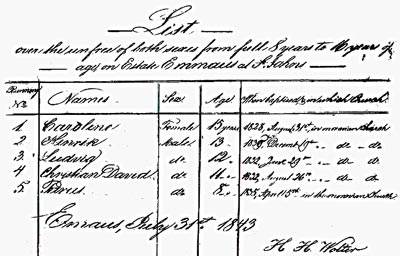
A page from the 1843 ‘Accounting of enslaved
children of St. John Estates’ identifies 5 unfree
individuals on Estae Emmaus
In addition to full coverage U.S. and Danish West Indies censuses, there are specialized census-like documents. For example, an ‘Accounting of enslaved children between the ages of 8 and 16 years’ was compiled in 1843. David Knight also cautions us that sometimes you need to know where to look — An 1824 “Registry of the Free Coloured Male Inhabitants of St John’s” (in English) is available only in the Danish Archives. An 1831 “List of Free Coloured for St. John” (in Danish) is housed only in the U.S. Archives. These records identify individuals by name, sex, age, religion, and occasionally occupation.
Some of the NARA and Danish Archive repository items prove surprisingly engaging. ‘Marriage Licenses 1897-1916’ includes_minified an amusing letter from a curate asking the government politely for rebate of a license fee he paid out-of-pocket on behalf of a couple whose bans were mispronounced; he clearly does not expect reimbursement! One personal moment is documented in a request for permission to marry signed by Knud-Hansen and Louise Therese Hassel.
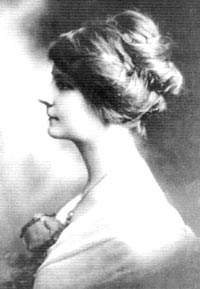
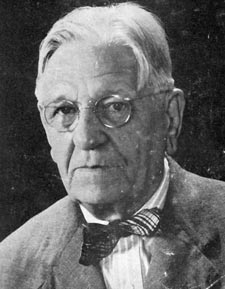
Miss Louise Therese Hassel and Dr. Knud-Hansen
(Picture at left, a pre-marriage picture of Miss Hassel and a late picture of Dr. Knud Knud-Hansen. The Danish Dr. Knud-Hansen stayed on after Transfer to help found the modern Public Health System in the V.I. His autobiography From Denmark to the Virgin Islands was published in 1947. Pictures of the Knud-Hansen family, many from the 1800’s, can be seen in his son John’s Island Memories and Later Years published in 1999.)
“Embarking on the quest ‘Who Am I?’ and sharing the journey and results builds personal and community ties,” Ms. Lugo says. The journey is easier with CGL’s resources. At the Library, several members jumped on-line to pursue quests for relatives; some browsed the international book collection; others scanned microfilm to peruse NARA’s Records of the Virgin Islands, looking at selections from Pamphlet M1883–Selected Records of the Danish West Indies 1672-1917; Estate Probate Inventories, Registries of Workers and Artisans, Marriages, Wills and Probates, Diseases and Causes of Death, and on and on…
Language does not appear to be a problem in reading these records, as English was commonly used except at the loftiest levels of Danish government. In fact, David Knight interjects, it’s sometimes easier for us to understand the old Danish records, as we are better acquainted with the place names and families here on the islands.
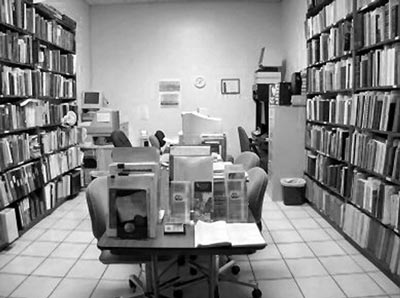
Caribbean Genealogical Library at Al Cohen’s Mall
The CGL is a branch of both the Federation of Genealogical Societies and the Family History Library of the Church of Jesus Christ of Latter Day Saints. The Latter Day Saints have been gathering and preserving genealogical records for over 100 years and have documents from 110 countries. To see the catalog of topics and census records (and to locate the target microfilm reel, available at CGL), sign on to http://www.familysearch.org.
Ms. Lugo also encouraged us in her presentation to use other web resources and listed many libraries, search engines, newsletters, and databases now available. To start, try:
- http://www.ancestry.com 5 billion names and 4000 searchable databases
- http://www.rootsweb.ancestry.com/ a free genealogy community web-based board
To appreciate the Caribbean Genealogy Library, you only have to visit it once! “All are welcome at the Library,” says Ms. Lugo, her enthusiasm infectious. “Our goal is to make records as accessible as possible to everyone.” Current projects at the Library include Oral History, Cemetery Transcription and Preservation, Records Transcription, Indexing, and Document Preservation….all in need of Volunteers!!
IMPORTANT POST SCRIPT–The Danish Cemetery
After visiting Susan Lugo at the CGL, about two dozen SJHS members spent the afternoon with some well-known families near Mafolie Hill–at the historic Danish Cemetery. The Cemetery is well-documented; see www.dkconsulateusvi.com and find the St. Thomas Danish Cemetery section for a layout of the cemetery, full transcriptions, and color pictures. It is, however, well worth a real-life stroll in congenial and interested company beneath the majestic mahogany trees.
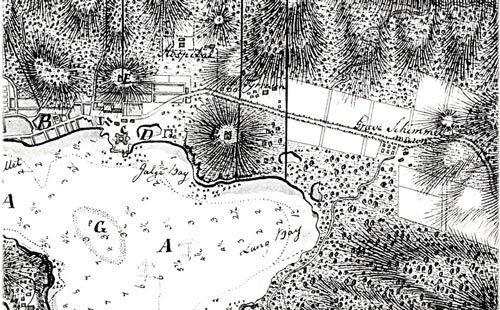
1778 Map of King’s Quarter by Peter Oxholm
As context for our St. Thomas guided tour, SJHS President David Knight provided two maps. The first, a ca. 1778 map of King’s Quarter, Charlotte Amalie, by Peter Oxholm clearly shows the Hospital Grounds, where the Cemetery now stands, and long-gone details of the harbor, including a salt pond near Galge (Gallows) Bay, and Hassel….Peninsula. Long North-South boundary lines mark off varying Estate widths in thousand foot segments–the more slaves owned, and the greater the capacity for productivity, the more land you were able to purchase.
The second map of Kings Quarter was produced by Thomas Therson ca. 1871. By that date, “town” has moved up the hill in rather orderly fashion; the Salt Pond by the Fort is filled in, and Emancipation Park is in evidence. The Hospital Plantagen (plantation) still occupies a goodly portion of provisioning land, and the Hospital remains in uncomfortably close proximity to the Cemetery.
This is a very eclectic cemetery, even considering the long 1666 and forward burial timeframe. The earliest graves were those of military and government employees and the latest of those born on St. Thomas under Danish rule. There are simple slabs side by side with European-style granite vaults, above-ground cut coral block and granite block monuments, family mausoleums, plots with layers of family members, and unadorned cairns. Some burial plots and vaults are imbedded with conch shells, lips opening out to release the spirits said to reside within. Most of these latter monuments bear no epitaphs today. Ironwork imported by local companies like Briscoe & MacDougall from New Zealand enhances several family plots, their designs echoing grillwork on houses of the time.
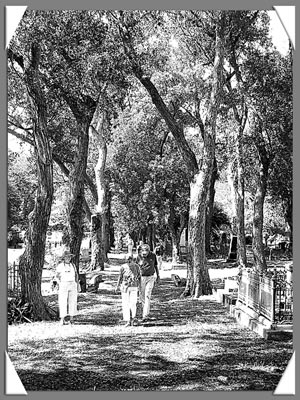
Danish Cemetery, St. Thomas
Among the luminaries at rest here are Catherine and Hans Hendrik Berg (1788-1862), Governor and Commandant of St. Thomas and St. John 1848 and 1853-62. One of his claims to fame was the Berg Land Grants on St. John. Undeterred by the convention that Estates could not be subdivided, he proceeded to set aside parcels of his plantation and give them as free holdings to emancipated slaves at his death.
Also interred here is Dr. Viggo Christiansen (1875-1948); he renamed the Danish West Indies ‘The Virgin Islands of the United States’ after Transfer.
